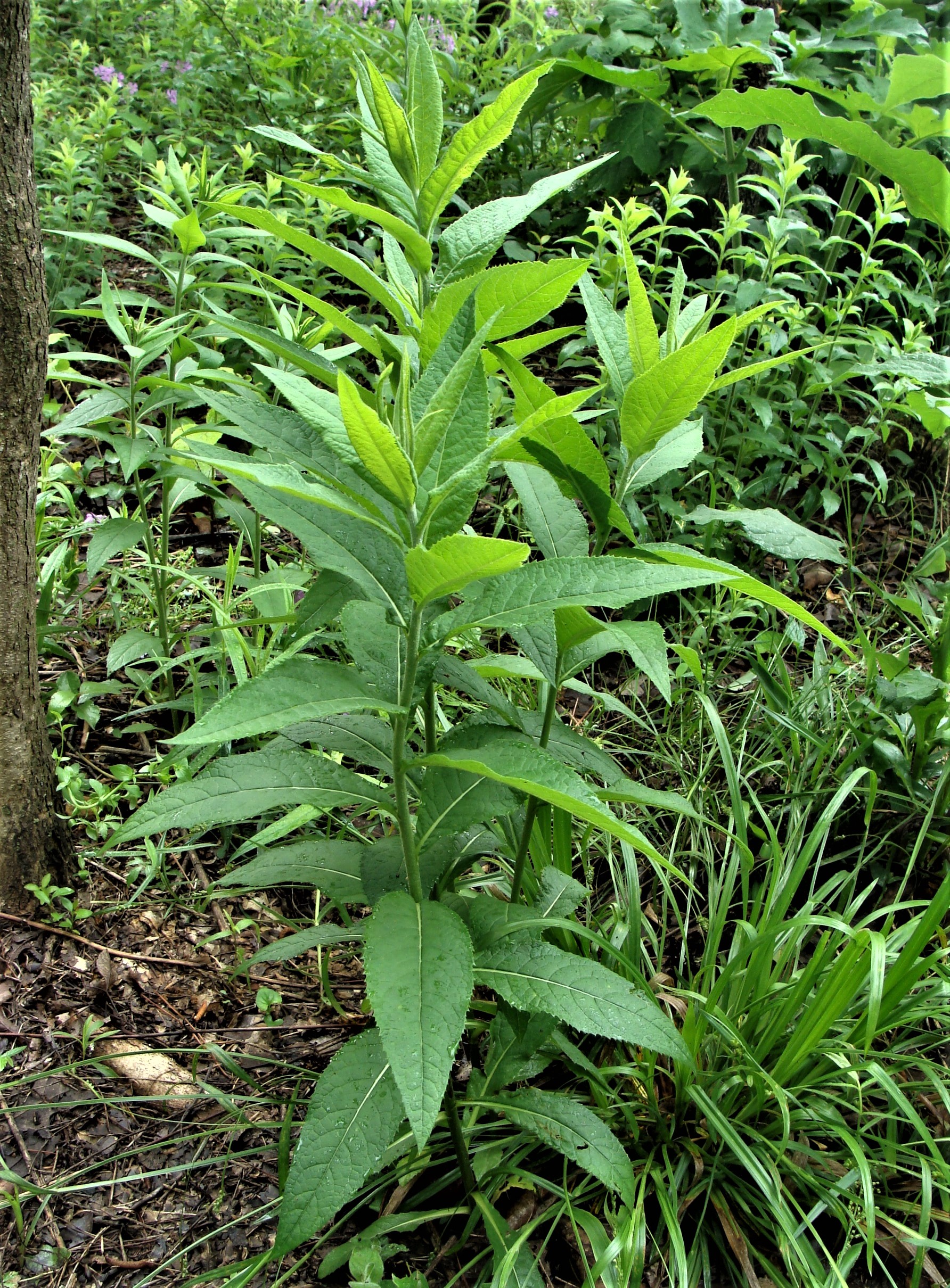Baldwin’s ironweed (Vernonia baldwinii) of the Sunflower or Aster (Asteraceae) family is a tall plant with a vivid purple inflorescence. In the U.S., it occurs principally from central Texas north to Nebraska and Iowa and east to Illinois and Arkansas. In Arkansas, it is found in the northwestern two-thirds of the state, primarily within the Interior Highlands. The genus name recognizes William Vernon, an English botanist who worked in Maryland in the late 1600s. The specific epithet recognizes William Baldwin, the original collector of the plant. Habitats have somewhat dry to slightly moist soils in open upland-woods, prairies and rights-of-way.
This sturdy herbaceous perennial has a whitish root-crown from which numerous ropy roots extend in all directions. As central stems die at the end of the growing season, short (less than an inch) rhizomes extend from the old rootstock and produce new stems immediately adjacent to the dead stems. The dead woody core of the older rootstock persists.

Stems bearing current year’s growth are erect, straight, tough, and brittle, typically 3 to 4 feet tall, but occasionally taller in preferred habitats. Stems are unbranched below the inflorescence. Floral branches, up to 10 inches long, spread widely from the main stem at the top of the plant. Stems and branches are typically tomentose (with short, soft, dense hairs), however pubescence is variable from plant to plant. Stems are round in cross-section.


Plants bear alternate, lanceolate to lance-ovate leaves with acuminate apexes and rounded tapered bases. Leaves have a slightly shiny, medium to dark green adaxial surface and a duller lighter green abaxial surface. Leaves may be short-petiolate or sessile. Pubescence of stems and branches extends onto the petioles, as well as to the midrib and lower surface of the leaf. The upper surface of the leaf blade may be scabrous (rough) to nearly glabrous. Leaves are large from plant base to floral branches, up to 8 inches long and 2 inches wide. Larger leaves are serrate along most of their length, with minute bristly yet soft teeth where veinlets terminate.

Flowerheads of Baldwin’s ironweed consist of disk flowers only (no ray flowers). The showy, somewhat flat-topped inflorescence measures a foot or more across and comprises a complex, branching arrangement of the heads in cymose arrays. Pubescence of the stems and branches continues onto the peduncles (stalks of groups of flowerheads) and pedicels (stalks of individual flowerheads). Flowering sequence is from the center of arrays outward, with those that terminate the main stem blooming first.

Flowering begins in mid-July and continues for several weeks. Heads consists of a compact group of 15 to 35 (typically 20 to 30) disk flowers, set in a campanulate (bell-shaped) to spherical involucre. The involucre comprises 5 to 6 series (layers) of tightly imbricated (overlapping) phyllaries (bracts). Phyllaries typically bear acute, recurved tips, giving the involucre a bristly appearance.
As anthesis approaches, heads develop a rusty-brown, dense, broom-like cluster of bristles. (This is the “pappus,” a modified calyx and a distinctive character of the sunflower family that takes a variety of forms, for example, in addition to bristles, scales and awns. The pappus often is the agent of seed dispersal.) Each disk flower produces a purple tubular corolla (occasionally pink and rarely white), with five acutely tipped, recurved lobes, which pushes up through the pappus and, en mass, forms an attractive flowerhead. Anthers of the 5 stamens are fused into a ring around the style. As the style elongates through the anthers, it carries the pollen above the corolla, where it can be picked up by pollinating insects. Stamens soon wilt, after which the upper portion of the style divides and coils backward to expose two elongate stigmatic surfaces.


Shortly after anthesis, the corolla, stamens and style fall from the flower, and the ovary matures to become a flattened, elongate, 1-seeded achene (often referred to as a cypsela in the Aster family)–the familiar sunflower “seed” is one such achene. The pappus, attached at the tip of the developing achene, fluffs-up to form a circle of radiating, ascending bristles. As achenes dry, they separate from the receptacle and are dispersed by breezes.
Baldwin’s ironweed may be appropriate in a larger garden–at 3-4 feet tall, probably best suited for a naturalistic garden or natural area. It readily grows in various well drained soils. Its purple flowers are showy and attract butterflies and other insects. It is not eaten by deer.
Baldwin’s ironweed is one of seven ironweeds known to occur in the state. Species that have similar characteristics and are also widespread in the state are tall ironweed (Vernonia gigantea) and Missouri ironweed (Vernonia missurica). The best characteristic to identify Baldwin’s ironweed, considering the somewhat variable leaf shape and pubescence of the three species, is its recurved phyllaries which cause involucres to appear bristly. Tall ironweed has blunt appressed phyllaries, and Missouri ironweed has appressed pointed phyllaries. Additionally, tall ironweed leaves are not tomentose on the undersides and Missouri ironweed flowerheads consistently have over 30 florets (sometimes upwards of 50). Where ranges overlap, ironweeds may hybridize.
Article and photographs by ANPS member Sid Vogelpohl


Pingback: Know Your Natives – Missouri Ironweed | Arkansas Native Plant Society